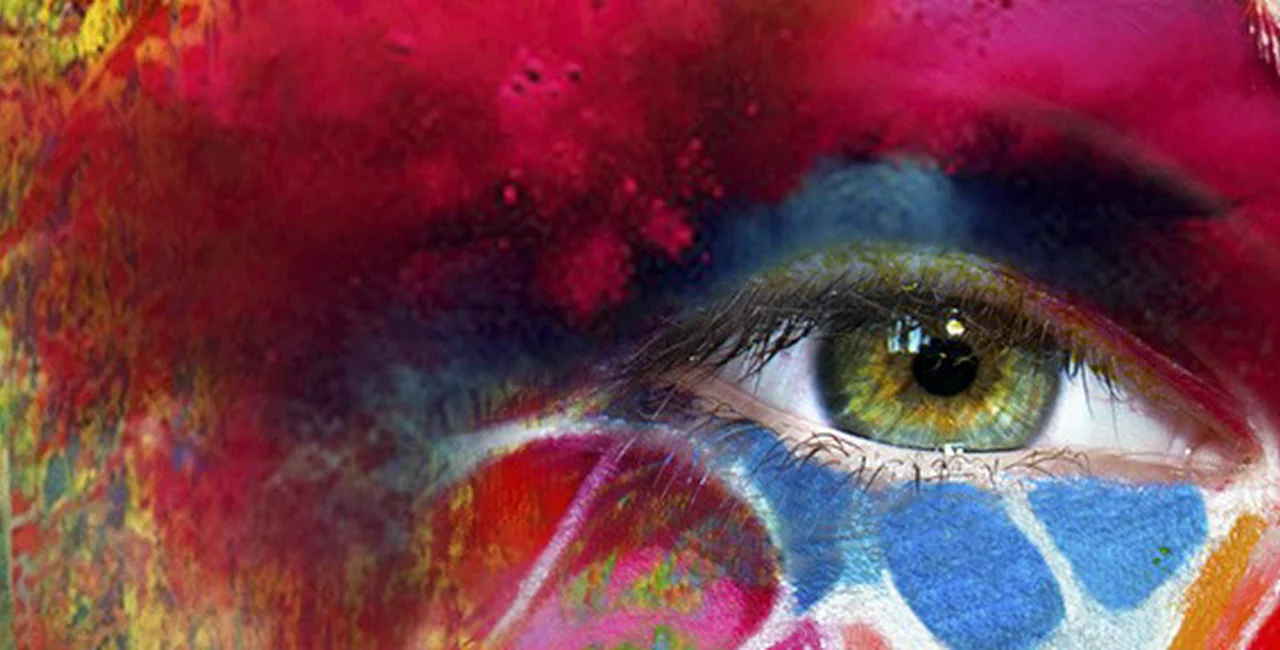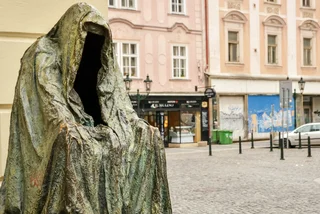Archivo Sur – Art Between Identity and the Mask
The Archivo Sur exhibition at FUTURA is a big deal. Huge.
From now through November 30, the exhibition offers the most extensive and exhaustive presentation of Latin American art exhibited in the Czech Republic to date. This elaborate collection of installations—no quick and simple walk-through—requires an afternoon of thoughtful immersion in a region rich in culture and history, and beleaguered by political and social turmoil. Each of the participating artists is a prominent and honorable figure in the world of contemporary art, having contributed heavily to the emergence of the artistic movement in Latin America, and having merited international recognition as innovative members of the modern artistic scenario. Archivo Sur takes what we know—or what we think we know—about this region of the world and energizes it with vivid imagery, to colorize and add tremendous depth to mere factual knowledge, while also generating important questions around concepts such as identity, the meaning of borders, diversity, and socioeconomic gaps.
According to curator Antonio Arévalo, “´Archivo Sur´ not only has received a positive welcome from specialized critics, but it also represents an opportunity to approach a region that has gone through deep, social, political, and cultural transformation. “ And on the work of the featured artists, Arévalo adds, “They don´t show exact records, but set up a sarcastic and ambiguous game of ideas, where everyone takes part. Images are embedded with contrasts of sacred and profane, innocence and corruption, good and bad. Latin America may look fragmented, but it expresses itself as a whole, favoring a restless diffusion of its culture, and with a deep self awareness of its being.”
Columbian artist Carlos Motta´s contribution to the exhibition is entrancing. Motta now lives and works in New York City, where his work has been exhibited, rewarded, and reviewed left, right, and sideways. His work has not only received recognition by such publications as The New York Times, ArtForum, and many others, but it has been featured in both solo and group exhibitions all over the globe, including Paris, Rome, Amsterdam, San Jose, Sao Paulo, and Stockholm. Motta is the editor of artwerl.org, and faculty member at the International Center of Photography and Parsons, The New School for Design, in New York. His grants and awards include the Guggenheim Fellowship, awarded just this year, the Art Matters Foundation, among many others in New York, and the IASPIS in Stockholm, as well as the Danish Arts Council.
Motta´s art is deeply rooted in his Columbian origins. His work, primarily photography and video installation, is a reflection of where he was born and raised, Bogota, Coumbia, a hub for this notorious nation´s political turmoil and guerilla violence. His art focuses on strategizing with documentation of specific political events to observe their effects and suggest alternative perspectives on these historical pivots.
A large wall is brightly covered with rows of faces, graphic headshots that are digitally manipulated to abstraction, in the first part of Motta´s installation, “Pesca Milagrosa.” What does this seemingly random group of people have in common? It´s key to being moved by the piece.
Its been described by the UN as one of the world´s worst humanitarian crises. It is considered the most dangerous location in the entire world for media associates and journalists. Columbia has been plagued by violent conflict involving armed rebel groups, drug cartels, and gross violations of human rights. The most well known violent group, the FARC (Revolutionary Armed Forces of Columbia), has hardly ceased its rebellious agenda of drugs and kidnapping since its emergence in the mid-‘60s. Just in July of last year, hundreds of thousands of Columbian citizens banded together in protest of the civil conflict, demanding the release of over 3000 people still being held hostage.
Imagine this: Columbian guerillas erect roadblocks on national motorways, where they stop any and all vehicles, and decide who will be kidnapped. How do they decide? By running identities through a computer system that researches the victim´s financial capabilities. (Take into account that Columbia produces over 80% of the world´s cocaine, and questions of funding such technology and weaponry are basically answered.) It´s a technique called “Pesca Milagrosa,” which means “miracle fishing,” and the photos that cover the gallery wall with rows of innocent faces are the victims of forced disappearance in this game of “inhumane roulette.”
In addition to this piece, Motta´s documentary video, Settembre 22, also focuses on the terror and infringement of human rights in Columbia. But from this perspective, the scenes display the abuse of power from the police against dealers and traders.
Alejandro Gómez de Tuddo is another prominent name in contemporary Latin American art. Born in Mexico City, Gomez has studied photography and filmmaking in Paris and New York, and his work has been exhibited all over the Americas and Europe. He has worked for various international photographic agencies and magazines, including Vogue, and his work has been published in three books, including “Aura de Dragones” (1999), “Mexico Inedito” (2001), and “Guadalupe” (2003). He has participated heavily in several artistic projects in Mexico with the Ministry of Culture, Tourism, and Internal Affairs, and other public and private institutions, and currently resides in Rome, Italy.
Gómez de Tuddo´s contribution is a 30-minute short film on “El Niño Fidencio,” a legendary name in Espinazo, in northern Mexico, around which many “colorful” stories have been told. In the 1920´s, El Niño Fidencio was brought to fame in Espinazo for his miraculous healing powers, which attracted thousands of sick and injured visitors. Exact details of his life are hard to come by, as fact and myth created a blur over the decades, but the cures of El Niño inspire roughly 30,000 modern visitors to Espinazo twice a year, where they make the pilgrimage to “adopt his soul” and perform rituals to assume El Niño´s healing powers.
Peruvian artist Patricia Bueno´s work undeniably gets under one´s skin (http://www.patriciabueno.com/). It´s as captivating as it is creepy; it exudes a bold, highly abstract style that has made her work strongly identifiable in contemporary Latin American art. “Tuyo es el Reino” is a nine-minute psychological thriller that combines women, mannequins, and masks in a three-dimensional moving metaphor for the power of the state and the parting interests of a nation that belongs to a select few. The intricate composition of shots is somehow delivered with an illusory slowness, and the mysterious dialogue, symbolic signs, and melancholic music deliver a haunting schizophrenic piece. The film is visually rousing, and is as certain to provoke multi-faceted contemplation as it is to raise goosebumps.
“Aequatorlab” is a major highlight of Archivo Sur. This highly stimulating installation is composed of video and photography, with the cartographical background of the Equator´s line across South America. It is one line that divides the world in two parts, a metaphor of the difference between First and Third World countries, and an audiovisual journey that passes through different cities along that imaginary line. Look through the hanging lenses to find the people, places, and stories from the various local points of view, yet under an artistic narration that creates bridges of communication from one place to the next. This installation also serves to unify the places along the Equatorial line. Aequatorlab requires viewers´ participation on an active journey across places and stories, and commands reflection on the meaning of borders and limits. This installation´s artists, Maria Rosa Jijon of Ecuador, and Juan Esteban Sandoval of Columbia, in collaboration with Fabiano Kueva, have each been key players of the contemporary art scenario, and have been recognized for artistic achievement across the Americas as well as Europe—both above and below the Equator.
In a 2006 interview for Streaming Festival (http://www.streamingfestival.com/), artist Giancarlo Pazzanese said, “I’m a 50 percent Chilean and 50 percent Italian immigrant living in Holland since 2002. I went to a snob school in Chile where I learned English and came to live in this country thinking that here there was more tolerance and less discrimination, which turned out to be a mistake. Since then I work on transcultural issues on identity and sexuality. Trying to have a distant perspective and critical look upon the global world that we created for ourselves.”
Pazzanese´s installation is a 15-minute film in which the artist produces chalk portraits of Latin American revolutionaries, “based on portraits that have been reproduced so many times that they´ve blurred into signs,” according to Futura´s description. “ As a crowd gathers to gaze at the creations, he then plays a game of hopscotch over the faces, subsequently defacing them. “While jumping, he wonders about the passing nature of human memory and the never-ending rediscovery of the picture of the revolutionary as a temporary symbol of human society.” On the exhibition´s opening night, Pazzense also created a chalk portrait, which is still there as part of his installation. (Look but don´t touch! One sneeze in this piece´s direction could blow it all away.)
Archivo Sur also presents the striking work of other esteemed, world-renowned artists, such as Alexander Apóstol, Tania Bruguera, Jota Castro, Donna Conlon, Juan Downey, Regina José Galindo, Diango Hernández, Antonio Manuel, and Iván Navarro. No matter the subjective artistic opinion of viewers, each installation is undeniably powerful and fresh.
And what better place to enjoy such a powerful exhibition than within the architectural confines of Futura? This gallery amplifies the magnitude of stimulation by providing a mysterious space, filled with twists and turns and alcoves that enrapture its visitors in an artistic labyrinth.
Overall, Archivo Sur is as visually stimulating as it is thought provoking and awe-inspiring. It benefits the outside perspective of life in Latin America, while engaging viewers in the creative and innovative emergence of contemporary art deeply inspired by the region. It is a privilege for Prague inhabitants to have an opportunity to view an exhibition of this depth and caliber.
FUTURA is located in Smichov, at Holečkova 49.
Jessica Rose can be reached at jessica@expats.cz












 Reading time: 8 minutes
Reading time: 8 minutes 































